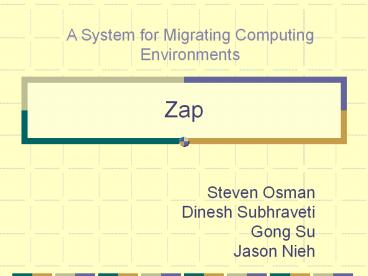Zap - PowerPoint PPT Presentation
Title:
Zap
Description:
A System for Migrating Computing Environments Zap Steven Osman Dinesh Subhraveti Gong Su Jason Nieh Benefits of Migration Dynamic Load Balancing Mobility Data Access ... – PowerPoint PPT presentation
Number of Views:74
Avg rating:3.0/5.0
Title: Zap
1
Zap
A System for Migrating Computing Environments
- Steven OsmanDinesh SubhravetiGong SuJason Nieh
2
Benefits of Migration
- Dynamic Load Balancing
- Mobility
- Data Access Locality
- Improved Administration
- Fault Resilience
3
Clustered System Approach
- Single system image across a cluster
- Good for load-balancing
- Examples include, MOSIX, Sprite
- May leave dependency on previous host
- May be new operating system or significant kernel
changes
4
Middleware/Language Approach
- Object-based approach using special programming
language or middleware - Examples include, Abacus, Emerald, Globus,
Legion, Rover - Requires applications to be rewritten
5
User-level Approach
- No operating system changes
- Good for long-running applications
- Examples include, Condor, CoCheck, Libckpt, MPVM
- Does not support many common operating system
services
6
Virtual Machine Monitor Approach
- Support any operating system
- No application changes
- Example, using VMware for migration
- Must migrate the whole operating system
- Potentially higher overhead
7
Introducing Zap
- Transparent migration
- Unmodified legacy applications
- Networked applications
- Commodity operating system
- Minimal operating system changes
- Leaves nothing behind
- Low overhead
8
Outline
- Background Motivation
- Difficulties of Migration
- Zap components
- Virtualization
- Migration
- Experimental Results
- Conclusion
9
Migration Difficulties
- int iChildPID
- if (iChildPIDfork())
- / parent does some work /
- waitpid(iChildPID)
- else
- / child does some work /
- exit(0)
10
Resource Consistency Problem
Host A
Host B
Parent invoked waitpid(20)
11
Resource Conflict Problem
Host B
Host A
PID 20
PID 20
Resources May Conflict With Other Processes
12
Resource Dependency Problem
Host A
Host B
Parent
Parent
Child
Parent and child depend on each other
13
Problem Recap
- Resource consistency
- Names cant change
- Resource conflict
- Names cant be duplicates
- Resource dependency
- Migration must be complete
14
Solution
- Group processes into a POD (Process Domain) that
has a private virtual namespace - PODs can contain one process, one group of
processes, or a whole user session - PODs are migrated as a unit
- Solves
- Resource consistency problem
- Resource conflict problem
- Resource dependency problem
15
Zap Architecture
- Zap combines
- Thin virtualization layer
- Checkpoint/restart mechanism
- Checkpoint/restart offers
- Easier to implement than demand paging
- Leaves nothing behind
- Suspend sessions
- Easily configure and clone environments
- Dynamic system configuration
16
What Should Zap Virtualize?
- Process identifiers (PIDs)
- Inter-process communication (IPC) keys
- Memory
- File system structure
- Network connections
- Devices
17
PID and IPC Key Virtualization Migration
- Create unique namespace for the POD
- Names are virtualized
- When entering a system call, replace POD virtual
identifiers with real ones - When exiting a system call, replace real return
values with POD virtual ones - Mask out identifiers that do not belong to the POD
18
Memory Virtualization Migration
- Like IPC, create unique shared memory namespace
- Modern architectures support virtual memory
Thank you modern architectures!
Migration optimization Move only data pages,
code pages can be remapped
19
File System Virtualization Migration
- Some filenames cant conflict
- /var/run/httpd.pid
- Some directories have unique configuration
- /etc
- Some directories depend on the current processes
- /proc
20
File System Virtualization Migration
- Create a directory structure for POD
- Use network file systems
- Create private POD directories
- Good for /tmp, /var POD specific configuration
- Private /proc directory
- Private /dev directory
21
File System Example
Host FS
binetcpod bin ? NFS/pods/bin dev
? Dynamic proc? Dynamic tmp ?
Private POD
POD FS
Use chroot() to map POD root directory
22
Networking Virtualization Migration
- Two network addresses
- Persistent internal address
- Host-dependent external address
- For connection migration
- Transport layer sees virtual address
- Network layer sees real address
- Transport layer independent
- Initial virtual address is real address
23
Virtual Networking
TransportADDR. 1
TransportADDR. 2
24
Device Virtualization Migration
- Device migration is hard
- Pseudo Terminal
- Sound Device
- CDRW During a Recording Session
- Electron Microscope
25
Device Migration Virtualization
- Pseudo Terminal ? Virtual device
configurationdata - Sound Device ? Virtual device configuration
- Recording CDRW ? Migrate later
- Electron Microscope ? Communicate with original
host
26
Device Migration Virtualization
- Unsupported devices do not appear in a PODs /dev
- Zap currently supports pseudo terminals, ensuring
their names are consistent after migration (e.g.
/dev/pts/2)
27
Zap Implementation
- Developed for Linux 2.4
- Zap design enables
- Loadable kernel module
- No need to rebuild the kernel
- Intercept system calls for virtualization
28
Zap Implementation
User space
User Processes
kernel space
ZAP Virtualization
System Calls
Zap Migration
Kernel
29
Virtualization Cost
- Created micro-benchmarks
- PID calls (getpid)
- IPC calls (shmget/ctl, semget/ctl)
- Process creation calls (fork, execve, exit)
- Used macro-benchmarks
- Apache
- Build Linux kernel
- Volano
30
Virtualization Results
31
Virtualization Results
- Zap incurs low overhead
32
Migration Cost VNC Session
33
Migration Cost Apache
- Apache 2.0.35
- Default configuration
34
Migration Cost Time
35
Migration Cost Space
36
Migration Cost
- Zap can be fast
- lt1 second checkpoint/restart times
- Includes Zap networking round-trip
37
Zap
- Offers transparent migration of legacy and
network applications - Introduces PODs
- Consistency
- Conflict free
- Avoids Unwanted dependencies
- Leaves nothing behind
- Fast and lightweight
38
For more information
- Zap computing
- http//www.ncl.cs.columbia.edu/research/migrate
- Network Computing Laboratory
- http//www.ncl.cs.columbia.edu/
39
Future Work
- Secure migration
- Trusted images, POD sandbox, etc.
- Generalized device support
- Migration policies
- Heterogeneity
- Contextualization
- Resource management































